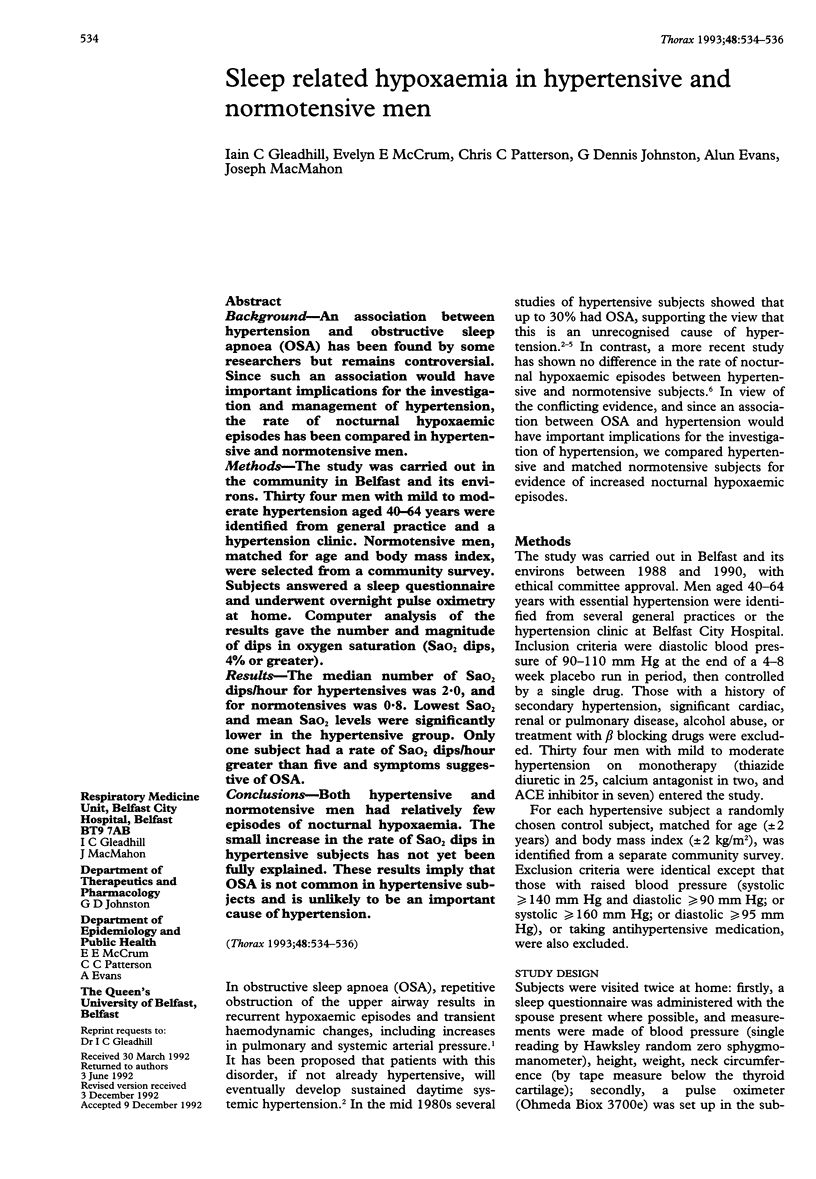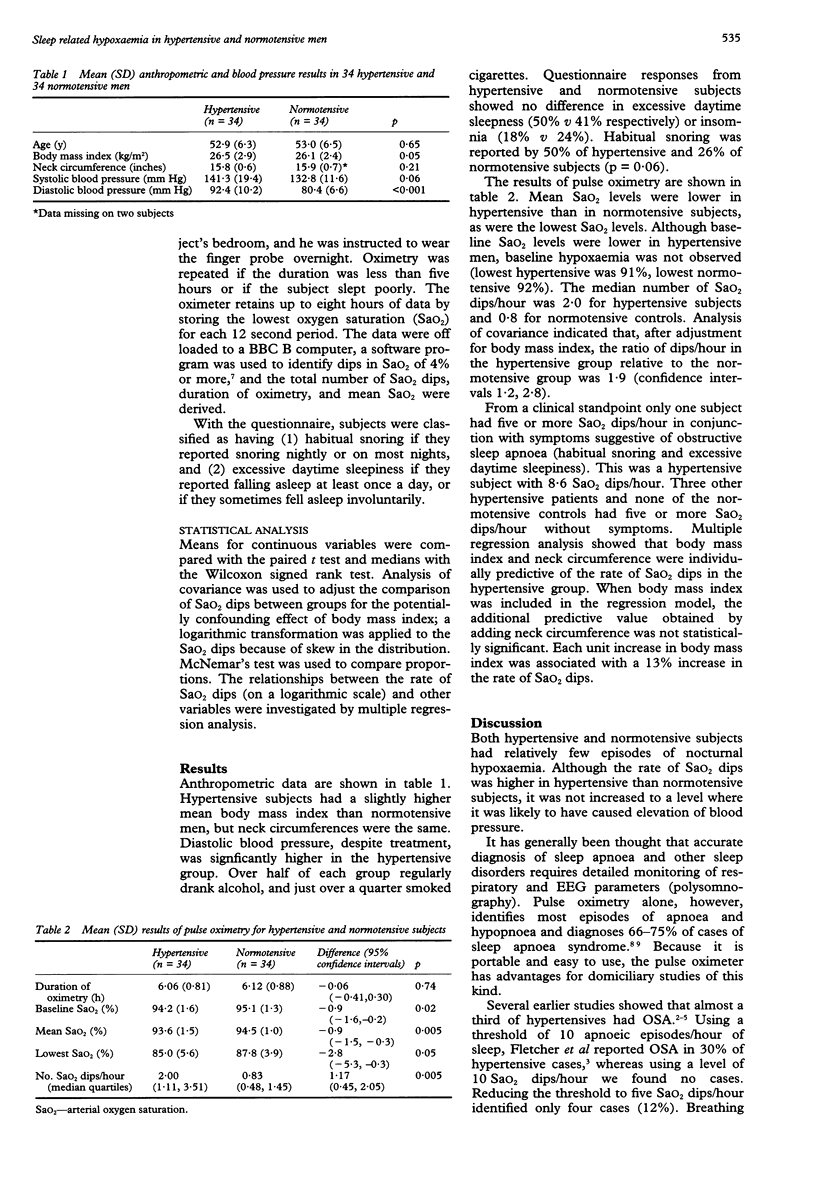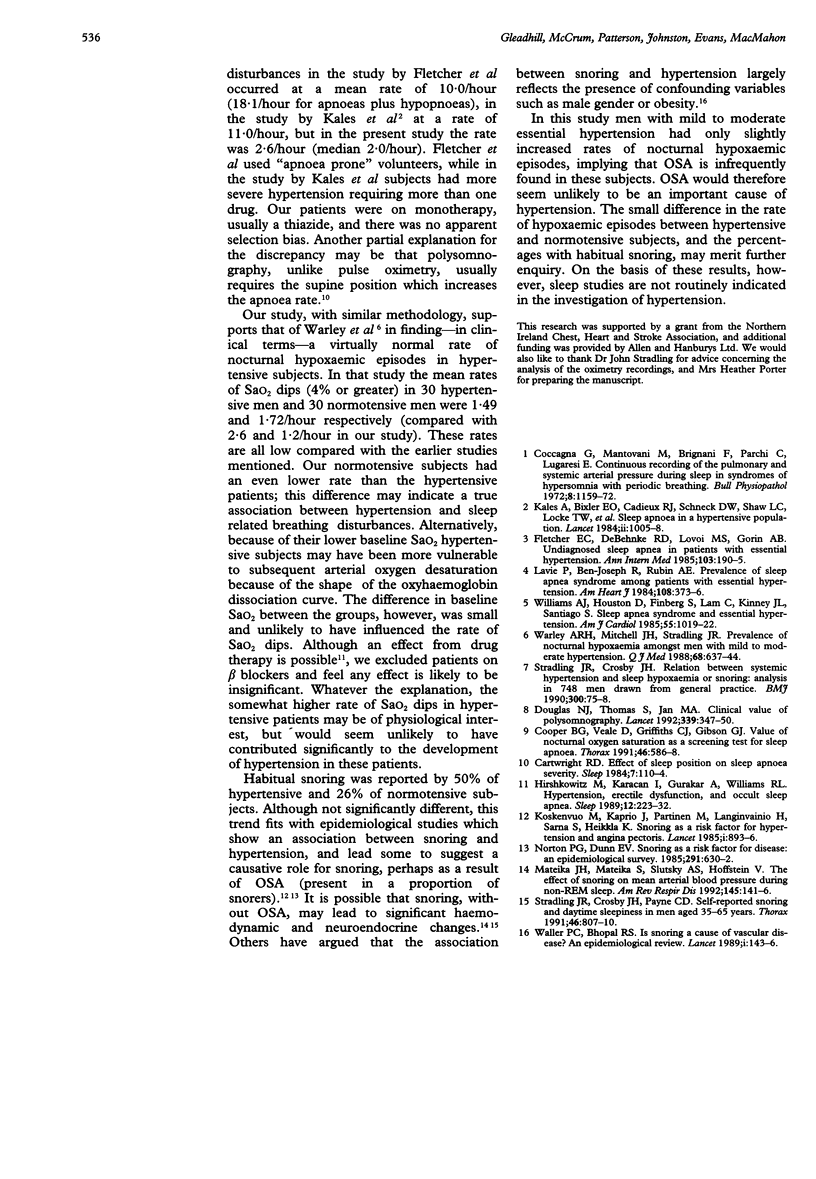Abstract
BACKGROUND--An association between hypertension and obstructive sleep apnoea (OSA) has been found by some researchers but remains controversial. Since such an association would have important implications for the investigation and management of hypertension, the rate of nocturnal hypoxaemic episodes has been compared in hypertensive and normotensive men. METHODS--The study was carried out in the community in Belfast and its environs. Thirty four men with mild to moderate hypertension aged 40-64 years were identified from general practice and a hypertension clinic. Normotensive men, matched for age and body mass index, were selected from a community survey. Subjects answered a sleep questionnaire and underwent overnight pulse oximetry at home. Computer analysis of the results gave the number and magnitude of dips in oxygen saturation (SaO2 dips, 4% or greater). RESULTS--The median number of SaO2 dips/hour for hypertensives was 2.0, and for normotensives was 0.8. Lowest SaO2 and mean SaO2 levels were significantly lower in the hypertensive group. Only one subject had a rate of SaO2 dips/hour greater than five and symptoms suggestive of OSA. CONCLUSIONS--Both hypertensive and normotensive men had relatively few episodes of nocturnal hypoxaemia. The small increase in the rate of SaO2 dips in hypertensive subjects has not yet been fully explained. These results imply that OSA is not common in hypertensive subjects and is unlikely to be an important cause of hypertension.
Full text
PDF


Selected References
These references are in PubMed. This may not be the complete list of references from this article.
- Cartwright R. D. Effect of sleep position on sleep apnea severity. Sleep. 1984;7(2):110–114. doi: 10.1093/sleep/7.2.110. [DOI] [PubMed] [Google Scholar]
- Coccagna G., Mantovani M., Brignani F., Parchi C., Lugaresi E. Continuous recording of the pulmonary and systemic arterial pressure during sleep in syndromes of hypersomnia with periodic breathing. Bull Physiopathol Respir (Nancy) 1972 Sep-Oct;8(5):1159–1172. [PubMed] [Google Scholar]
- Cooper B. G., Veale D., Griffiths C. J., Gibson G. J. Value of nocturnal oxygen saturation as a screening test for sleep apnoea. Thorax. 1991 Aug;46(8):586–588. doi: 10.1136/thx.46.8.586. [DOI] [PMC free article] [PubMed] [Google Scholar]
- Douglas N. J., Thomas S., Jan M. A. Clinical value of polysomnography. Lancet. 1992 Feb 8;339(8789):347–350. doi: 10.1016/0140-6736(92)91660-z. [DOI] [PubMed] [Google Scholar]
- Fletcher E. C., DeBehnke R. D., Lovoi M. S., Gorin A. B. Undiagnosed sleep apnea in patients with essential hypertension. Ann Intern Med. 1985 Aug;103(2):190–195. doi: 10.7326/0003-4819-103-2-190. [DOI] [PubMed] [Google Scholar]
- Hirshkowitz M., Karacan I., Gurakar A., Williams R. L. Hypertension, erectile dysfunction, and occult sleep apnea. Sleep. 1989 Jun;12(3):223–232. doi: 10.1093/sleep/12.3.223. [DOI] [PubMed] [Google Scholar]
- Kales A., Bixler E. O., Cadieux R. J., Schneck D. W., Shaw L. C., 3rd, Locke T. W., Vela-Bueno A., Soldatos C. R. Sleep apnoea in a hypertensive population. Lancet. 1984 Nov 3;2(8410):1005–1008. doi: 10.1016/s0140-6736(84)91107-3. [DOI] [PubMed] [Google Scholar]
- Koskenvuo M., Kaprio J., Partinen M., Langinvainio H., Sarna S., Heikkilä K. Snoring as a risk factor for hypertension and angina pectoris. Lancet. 1985 Apr 20;1(8434):893–896. doi: 10.1016/s0140-6736(85)91672-1. [DOI] [PubMed] [Google Scholar]
- Lavie P., Ben-Yosef R., Rubin A. E. Prevalence of sleep apnea syndrome among patients with essential hypertension. Am Heart J. 1984 Aug;108(2):373–376. doi: 10.1016/0002-8703(84)90628-8. [DOI] [PubMed] [Google Scholar]
- Mateika J. H., Mateika S., Slutsky A. S., Hoffstein V. The effect of snoring on mean arterial blood pressure during non-REM sleep. Am Rev Respir Dis. 1992 Jan;145(1):141–146. doi: 10.1164/ajrccm/145.1.141. [DOI] [PubMed] [Google Scholar]
- Norton P. G., Dunn E. V. Snoring as a risk factor for disease: an epidemiological survey. Br Med J (Clin Res Ed) 1985 Sep 7;291(6496):630–632. doi: 10.1136/bmj.291.6496.630. [DOI] [PMC free article] [PubMed] [Google Scholar]
- Stradling J. R., Crosby J. H., Payne C. D. Self reported snoring and daytime sleepiness in men aged 35-65 years. Thorax. 1991 Nov;46(11):807–810. doi: 10.1136/thx.46.11.807. [DOI] [PMC free article] [PubMed] [Google Scholar]
- Stradling J. R., Crosby J. H. Relation between systemic hypertension and sleep hypoxaemia or snoring: analysis in 748 men drawn from general practice. BMJ. 1990 Jan 13;300(6717):75–78. doi: 10.1136/bmj.300.6717.75. [DOI] [PMC free article] [PubMed] [Google Scholar]
- Waller P. C., Bhopal R. S. Is snoring a cause of vascular disease? An epidemiological review. Lancet. 1989 Jan 21;1(8630):143–146. doi: 10.1016/s0140-6736(89)91153-7. [DOI] [PubMed] [Google Scholar]
- Warley A. R., Mitchell J. H., Stradling J. R. Prevalence of nocturnal hypoxaemia amongst men with mild to moderate hypertension. Q J Med. 1988 Aug;68(256):637–644. [PubMed] [Google Scholar]
- Williams A. J., Houston D., Finberg S., Lam C., Kinney J. L., Santiago S. Sleep apnea syndrome and essential hypertension. Am J Cardiol. 1985 Apr 1;55(8):1019–1022. doi: 10.1016/0002-9149(85)90738-6. [DOI] [PubMed] [Google Scholar]


